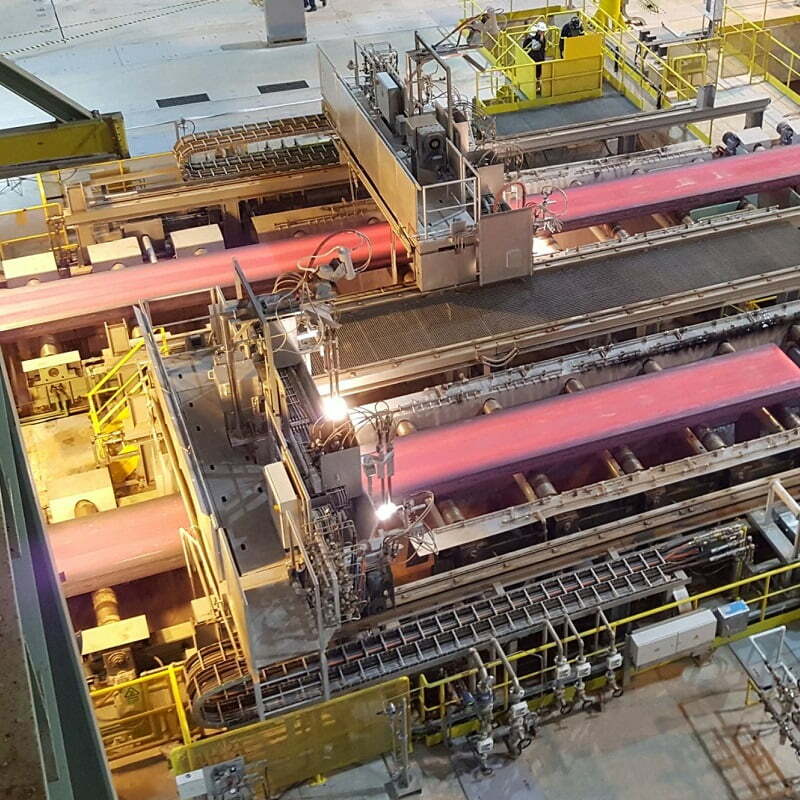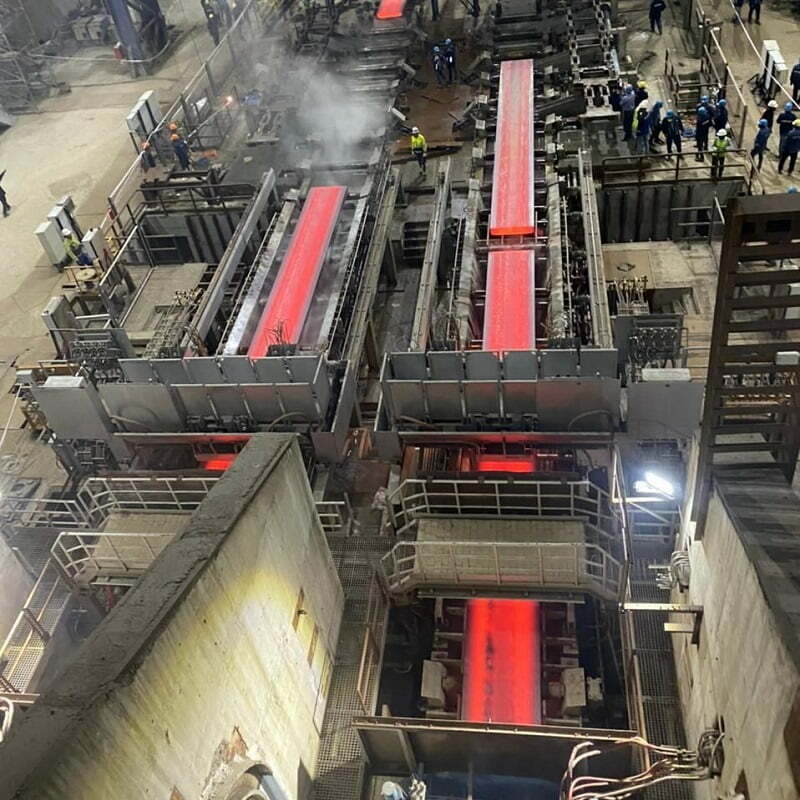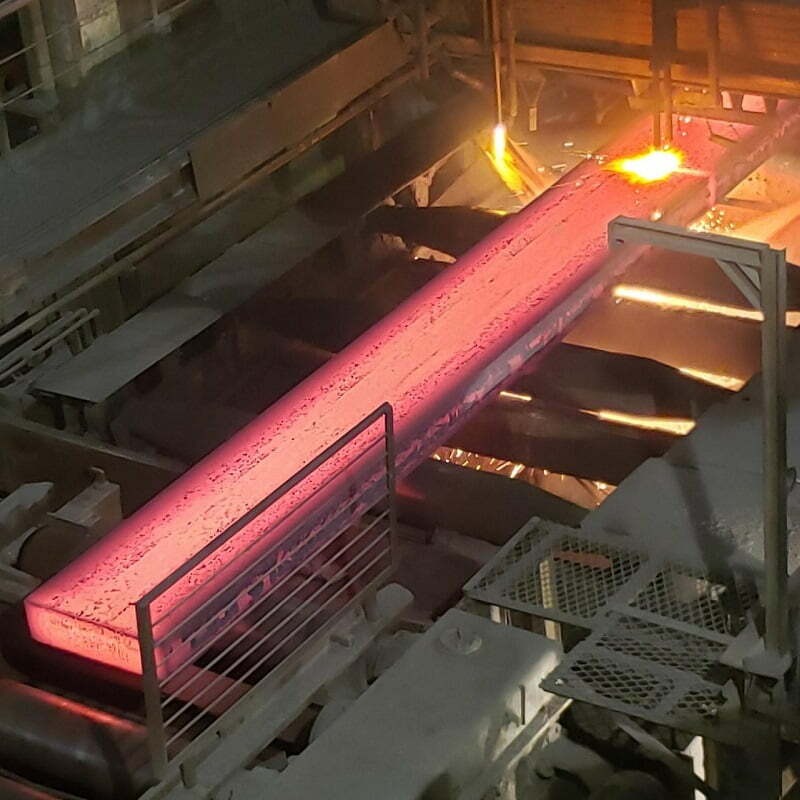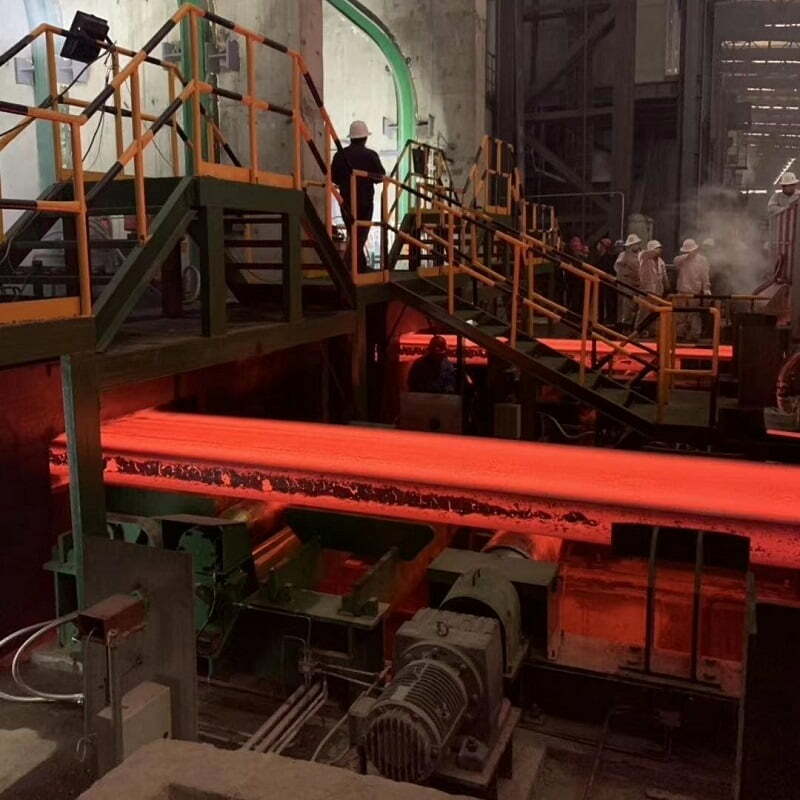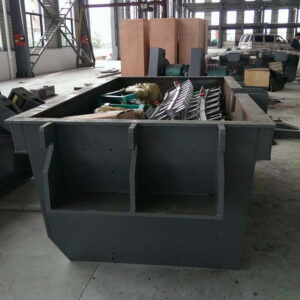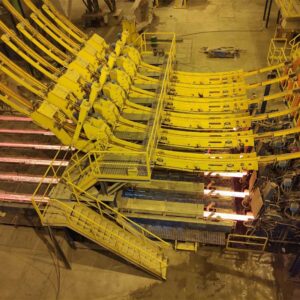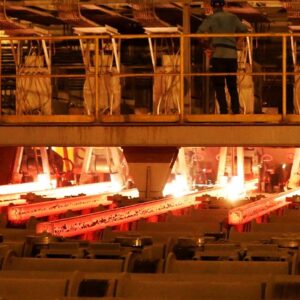Description
Slab Continuous Casting Machine
Slab Continuous Casting Machine: Slab continuous casting is a continuous casting and ironmaking technology with the slab as the main product. The slab with slab width thickness ratio greater than 3 is called slab. Continuous casting and rolling steel slabs are mainly used for rolling flat plates (thick plate, medium plate, thin plate, and strip coil).
Generally, the slab size cast by the continuous caster is 150 ~ 250mm thick and 1000 ~ 1800mm wide; The width of the small slab can be 600mm and the thickness is 120mm. A slab with a thickness of less than 100mm is called a thin slab.
Due to the large width thickness ratio of the slab, slab continuous casting has its uniqueness not only in the structure of continuous caster but also in production technology.
Protective Pouring
(1) The tundish with large capacity and high tank body is conducive to the floating of inclusions on the one hand, and on the other hand, maintaining a certain height of steel liquid level during continuous pouring of ladle replacement to prevent slag from being drawn into the mold to form internal defects, and at the same time, it can not reduce the drawing speed;
(2) Between ladle and tundish and between tundish and crystallizer, refractory products are used to isolate steel flow from the air and prevent secondary oxidation of molten steel;
(3) Continuously and evenly add protective slag into the mold automatically.
Crystallizer
(1) It is made of a copper alloy plate containing silver, chromium, zirconium, and other elements. This material not only has good thermal conductivity, but also improves the recrystallization temperature, and can maintain sufficient strength and hardness under high-temperature conditions; The inner surface of the copper plate can also be coated with nickel and chromium to improve the wear resistance and prolong the service life of the mold;
(2) Mold breakout prediction. Multiple thermocouples are installed on the four copper plates to measure the temperature change, which can make predictions according to the temperature change before breakout to prevent breakout accidents;
(3) Automatic liquid level control. The steel level detection in the crystallizer is mechanically interlocked with the opening and closing of the water inlet of the tundish to control and stabilize the steel level;
(4) In the case of slab hot delivery, hot charging, or direct rolling, in order to meet the requirements of a rolling unit for the combination of slab width, adjust the width of mold, reduce shutdown while meeting the change of slab width, so as to improve the operation rate;
(5) The mold vibration device adopts high frequency and small amplitude, which can improve the surface quality of the slab. The vibration frequency is generally 180 ~ 300 times/min and the amplitude is ± 2 ~ 8mm.
Billet Guide and Secondary Cooling Zone
(1) The guide device with the small roll and dense roll distance is adopted to adapt to high drawing speed and reduce slab bulging deformation and internal defects;
(2) Electromagnetic stirring facilities are used in the secondary cooling zone to increase the equiaxed crystal zone of the billet and reduce and avoid defects such as segregation and central porosity;
(3) steam water spray cooling is applied in the two cold areas to make the cooling of the billet cool and even, so as to facilitate the production of the defect-free billet.
Ingot Drawing and Straightening
(1) Roll gap measuring elements are installed on the dummy bar to regularly measure the roll spacing between the inner and outer arcs of the secondary cooling zone, and timely find and correct the unqualified opening to ensure the quality of the slab;
(2) Multi-point straightening and continuous straightening are adopted to keep the billet within a small allowable deformation rate and prevent internal defects;
(3) Using compression casting technology, the longitudinal pressure is applied to the slab in the straightening area through the drive roll to offset the tendency of cracks caused by extended tensile stress during slab straightening deformation.
Computer Control System and Other Devices
Improve the automatic control level of the whole machine, automatically monitor the secondary cooling and slab cutting length, and monitor the operation of various parts of the slab continuous casting machine and adjust them in time.
(1) Adopt insulation measures inside and outside the machine. The edges and corners of the billet shall be insulated inside the machine, and the transported billet shall be insulated outside the machine to keep it at a high temperature as far as possible to improve the energy-saving effect;
(2) Equipped with the deburring device, remove the cutting burr at the lower part of the billet to prevent it from damaging the rear roller;
(3) Variable frequency variable voltage AC motor is adopted to realize stepless speed regulation, so as to reduce maintenance work and improve the service life of the continuous caster.
Feature
The structural characteristics of slab continuous casting machine are mainly reflected in the secondary cooling zone and tension leveler.
Due to the large slab width, the slab coming out of the mold and entering the secondary cooling zone has not been fully solidified. Under the static pressure of molten steel, the slab is prone to bulge, resulting in increased drawing resistance or failure to pull out.
Therefore, dense guide rollers must be arranged in the slab Guide and secondary cooling device to control the bulge of the slab. The tension leveler also needs multiple rows of tension leveler rollers to pull out the slab. The drawing speed of modern continuous casting is high, and the billet of the tension leveler has not been fully solidified.
In order to prevent the belly of the billet and reduce the deformation stress inside the billet during straightening, the tension leveler is composed of more than 20 pairs of tension leveler rollers, which are designed as multi-point straightening or continuous straightening.
Due to the large width of the slab, the uneven heat flow distribution of the steel flow injected from the tundish in the mold will lead to longitudinal cracks on the surface of the slab, resulting in the waste of the slab.
Therefore, the submerged nozzle and protective pouring process are adopted to solve this problem.
Advantage
(1) The comprehensive yield of iron and steel is improved and the proportion of material loss is reduced;
(2) Reduce energy consumption;
(3) The products produced are of high quality and uniform;
(4) Easier to realize mechanical automation;
(5) Small floor area, fast production cycle, and low cost per ton of billet. These advantages have been successfully applied in the iron and steel industry, which has brought great changes to the whole iron and steel industry.
Customized Continuous Caster
We can design and manufacture the continuous caster according to the user’s steelmaking capacity, billet size, steel grade, and user site conditions. It can also be matched for manufacturers who already have continuous casting equipment.
Custom Range
Arc radius of casting machine: R2.5-10m
Billet species: square billet, round billet, slab, special-shaped billet
Continuous casting billet material: low carbon steel, low carbon alloy steel
Design production capacity: first-class 100,000 tons, second-class 200,000 tons, third-class 300,000 tons
Service
We can provide foundation layout and layout drawings
We will send engineers to your factory to install and debug machines and provide reliable after-sales service.
Competitive price and excellent quality
Our machines are easy to operate and maintain
Less investment
Stable performance
Products can be customized according to different needs
Production capacity can be adjusted according to customer requirements
Low energy consumption

